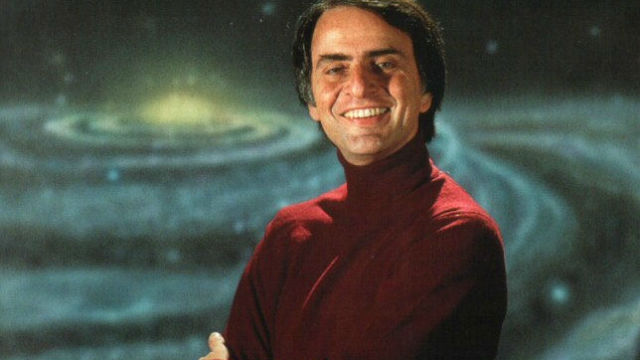Evidence of the Universe From Before the Big Bang?
How an observational signature from Cosmic Inflation could herald the scientific revolution of the century
“Despite its name, the big bang theory is not really a theory of a bang at all. It is really only a theory of the aftermath of a bang.” -Alan Guth
When you think back to the beginning of the Universe, you very likely think of a hot, dense, matter-and-radiation filled state that’s expanding and cooling at an incredibly rapid rate. (That’s correct, by the way.) But what you can’t do is extrapolate back to an arbitrarily hot, dense state. You might think that you can go all the way back to a “singularity” of infinite temperature and infinite density, where all the energy in the Universe was compressed into a single point, but that’s simply not true.
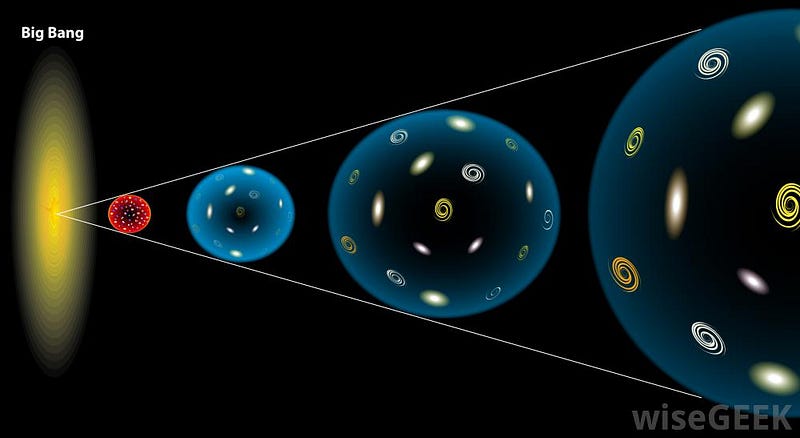
You see, one of the remarkable things about the Universe is that the radiation from this time is still around. While it bounced around between charged particles when the Universe was young, hot and ionized, that only lasted for the first 380,000 years or so. When the Universe became electrically neutral (as in, when the matter in the Universe formed into neutral atoms for the first time), that leftover radiation from the Big Bang simply sped in a straight line, unimpeded by this neutral matter.
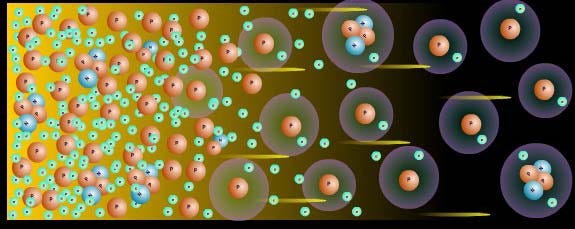
As the Universe has expanded — because the energy of radiation is defined by its wavelength — that radiation’s wavelength has been stretched by the expansion of space, and so its energy has dropped quite a bit. But this is remarkably helpful, because it gives us something to look for today.

And if we can see it and measure it, it can provide us with a window into the very young Universe! Well, in the 1960s, Arno Penzias and Robert Wilson found this leftover glow from the Big Bang — uniform radiation in all directions just a few degrees above absolute zero — and it was quickly recognized as the long-sought-after Cosmic Microwave Background!

Now, in the 50 years since, we’ve made tremendous progress. We’ve been able to not just measure the energy spectrum of this radiation, we’ve been able to measure the tiny, intrinsic temperature fluctuations in it, including what scales they occur on, how they’re correlated, and how that relates to the Universe.

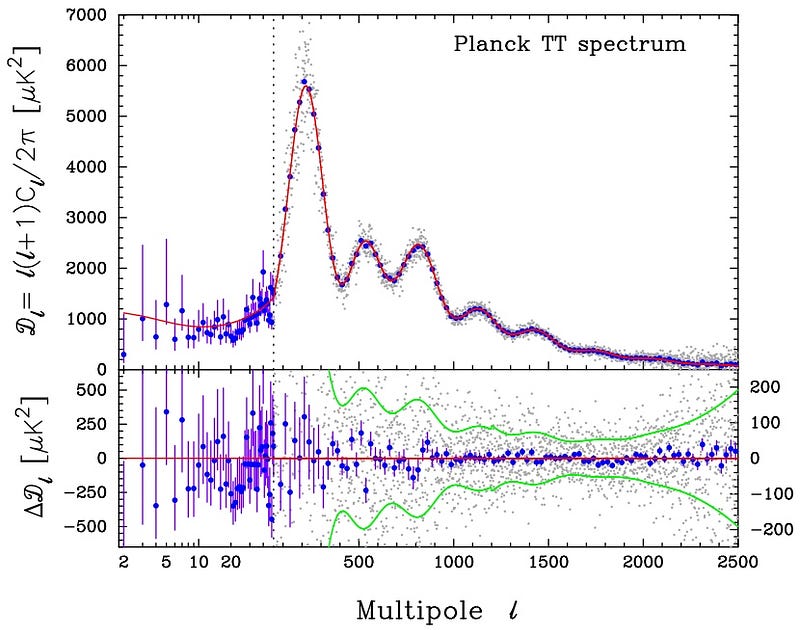
In particular, we’ve been able to learn about what the Universe looked like when it was 380,000 years old, what it’s made out of, and how the intervening matter has affected this radiation during its 13.8 billion-year journey to our eyes.
But there’s something else that can teach us information about these things as well; you see, it’s not just the energy and temperature of light on these scales, we can also look at how this light is polarized. Let me explain.

Light, at its most basic level, is an electromagnetic wave. This means it’s made up of oscillating electric and magnetic fields that are perpendicular to one another, it has a specific wavelength (defined by its energy), and it propagates at the speed of light.
When light propagates past charged particles, when it reflects off of a surface, or when it interacts with other electromagnetic phenomena in general, the electric and magnetic fields respond to their environment.

All light that’s produced initially is expected to be unpolarized, but a whole host of things can cause this light to become polarized in a variety of ways. In other words, this light that normally has randomly oriented electric and magnetic fields can experience interactions that cause it to have a preferential orientation, and that orientation can tell us some very informative things about all the things it’s interacted with over its history.

This polarization phenomenon of the Cosmic Microwave was first detected last decade by the WMAP satellite, and Planck is expected to do an even better job as time moves forward. (It is, however, very difficult to do this type of science correctly, and this should be noted.) Polarization that causes the light to have a “radial” appearance is what we call E-mode (for the electric field) polarization, and polarization that causes it to have a “twisted” appearance is B-mode (for magnetic field) polarization.
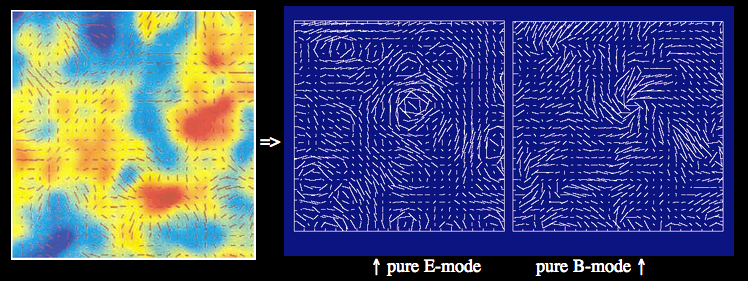
Most of the effect that is observed is due to the billions of light-years-worth of matter that the light has passed through; the stuff we call “foregrounds” in general. It has to travel all the way, and in all directions, from the radiation era in order to arrive at our eyes today.
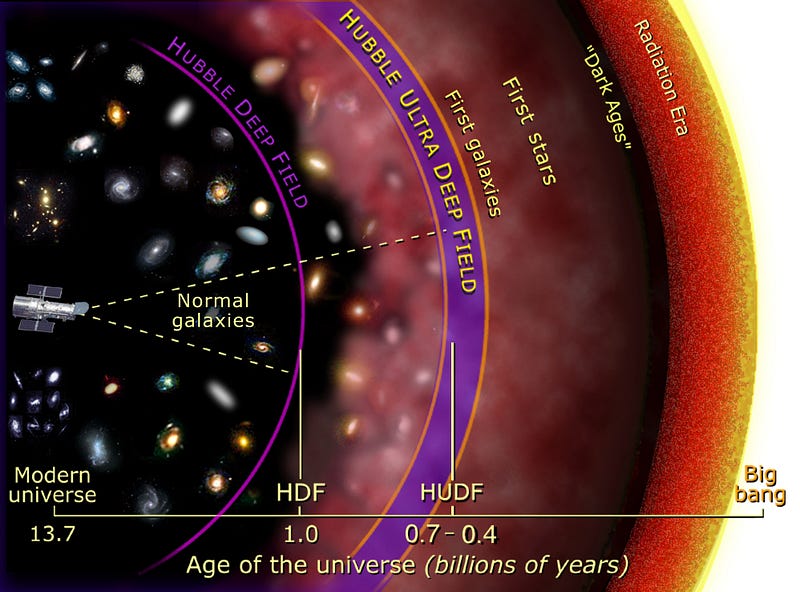
But there’s a little bit, a very small amount of polarization, that ought to come from even earlier. You see, back before the Big Bang — before the Universe could have ever been described by a hot, dense, matter-and-radiation-filled state — the Universe was simply expanding exponentially quickly; a period of cosmic inflation. During this time, the Universe was dominated by the energy intrinsic to empty space itself, an amount of energy far greater than anything in the Universe today.
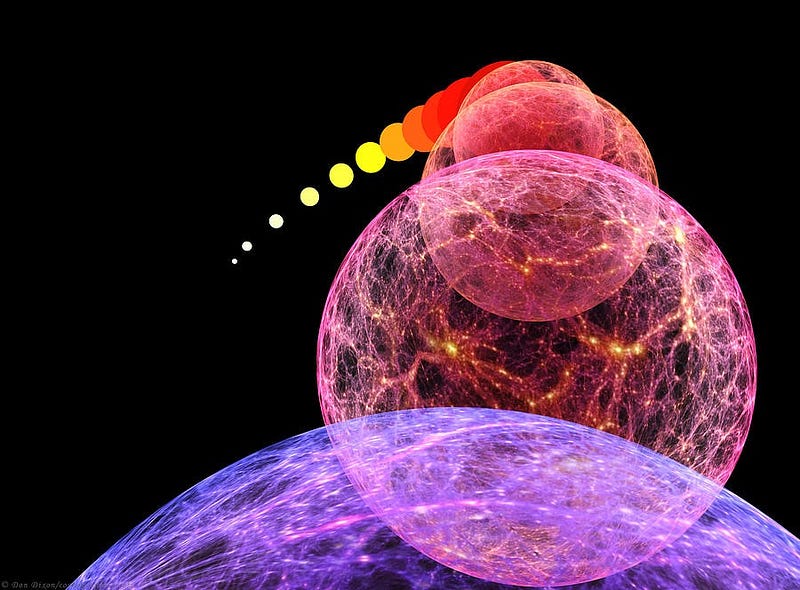
During this time, quantum fluctuations — fluctuations that happen inherently to space — get stretched across the Universe, and provide for the initial density fluctuations that give rise to our Universe today.
But it’s only in regions where inflation ends, and where that energy inherent to space itself, gets converted into matter-and-radiation that the Big Bang actually happens.
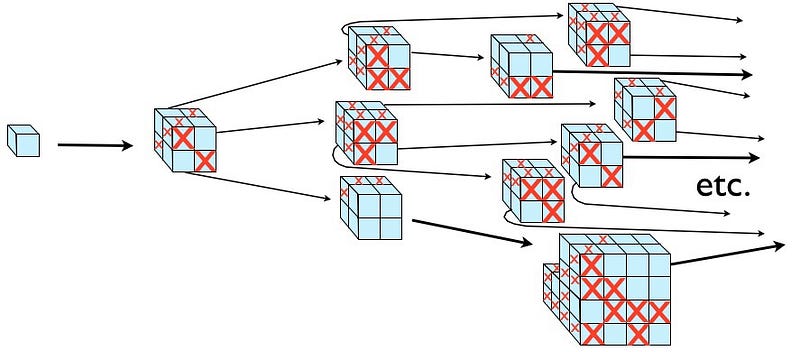
In these regions — regions where inflation ends — we get a Universe, and one that’s much bigger than just the part observable to us. That’s the idea of a Multiverse, and why we think we almost certainly live in one.

But what about inflation itself? Is there anything we can learn about that?
You might think that the quantum fluctuations — and the density fluctuations they seeded — are our only clue. In fact, up until yesterday, that’s what I would have told you. But in theory, inflation also produces gravitational waves, which we’ve hitherto been unable to detect. LISA, the Laser Interferometer Space Antenna (which is now pushed back into the 2030s at the earliest due to budget cuts), would have been our best hope for direct detection.

But even without LISA, the gravitational waves could still be detectable indirectly. You see, even though gravitational waves and light move at the same speed, light slows down when it travels through a medium. This phenomena occurs even the incredibly sparse medium of matter in intergalactic and interstellar space! And since gravitational waves don’t — they’re only affected by the curvature of spacetime — they can overtake the light waves, and cause polarization of their own!
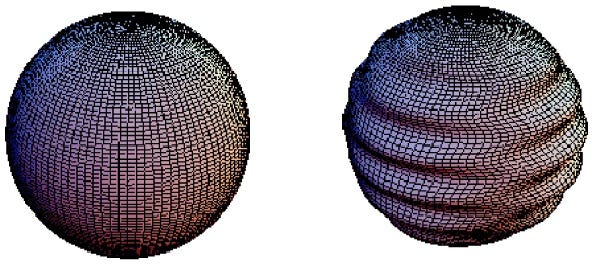
In fact, it’s these special deformations of spacetime, on specific scales, that will stretch the wavelengths of light in a very particular fashion as they travel from the Big Bang to our eye.

In particular, the telltale sign of gravitational waves is going to show up as B-mode polarization, and it’s going to leave a specific signature on somewhat larger scales.
Although Planck should see and confirm this, they were beaten to the discovery by a team working at the South Pole: the BICEP2 collaboration!
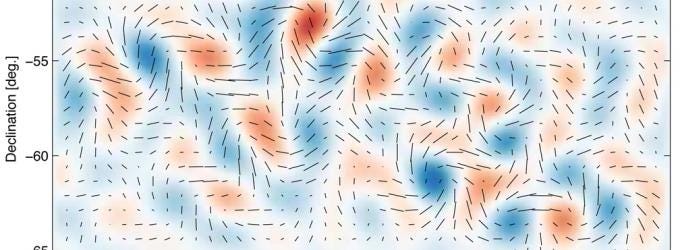
On scales between about one-and-five degrees, the B-mode polarization is very strongly evident, and has been reported to be discovered, albeit at 2.7σ significance. (Updated note: that’s 5.2σ significance on these particular scales, but they need to convince everyone that this level-of-detection isn’t due to a combination of foregrounds and systematics.) 2.7σ means there’s only about a 2% chance that this is a “fluke” detection that will go away as more data is taken! (That’s a big chance in the scientific world, so don’t sign-seal-and-deliver this just yet!)
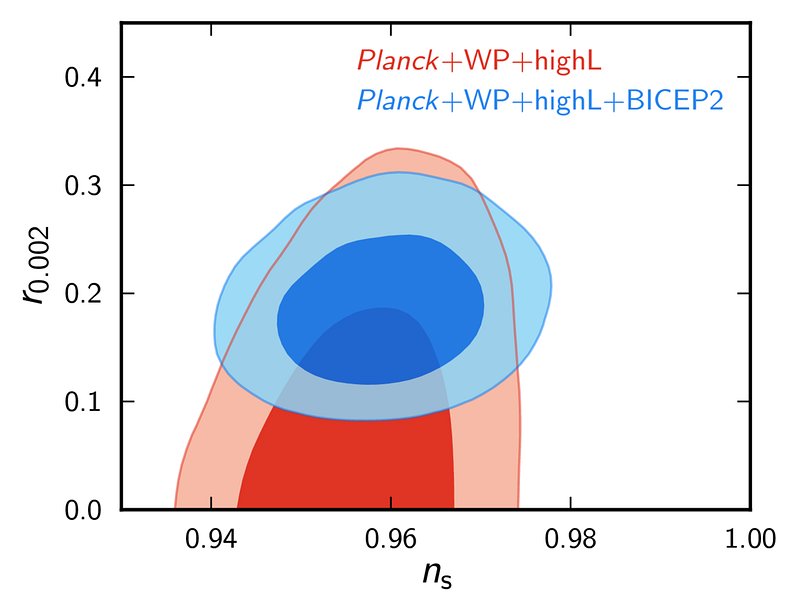
This is a huge deal if it holds up, because this is exactly the thing we would want to measure to not just figure out “did inflation happen” (it almost certainly did), but to figure out what model of inflation is the one that describes our Universe?
Planck, when it released its first results last year, didn’t detect anything at all as far as these gravitational wave relics go!

Now there are a few different “general” types of inflation that could have occurred: in particular, if that r-value in the graphs above turn out to be zero, that would favor the “small-field” model, but if it turns out to be something huge (like 0.2, as suggested by this result), that would be evidence for the “large-field” model.
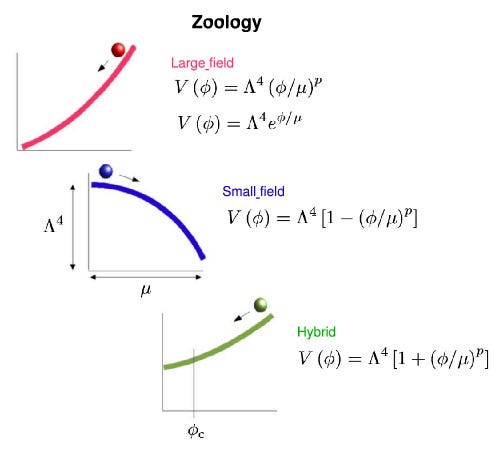
Now, is this a slam-dunk? No. We need much better statistics to announce this as a discovery; we simply cannot take these results to mean “yes there are primordial gravitational waves left over from inflation,” because we need better evidence. A 2.7σ result is nice, but in our robust world of physics, we need a confirmed 5σ result to be sure. The dustbin of physics history is littered with 3σ “discoveries” that simply disappeared with more and better data.
We know that inflation occurred; the seeds of structure in the Universe — the way it looks today, the way it looked 13.8 billion years ago and everywhere in between — has already told us that. But there’s a possibility, and the very first observational hints, that there might be gravitational waves left over, too. If it does turn out that we see them, we should be able to confirm it over the next few years. But if this observation regresses to the mean (and becomes insignificant) as we accumulate more data, it doesn’t mean inflation is wrong, only that it isn’t one of the models that produce the greatest B-mode signatures.
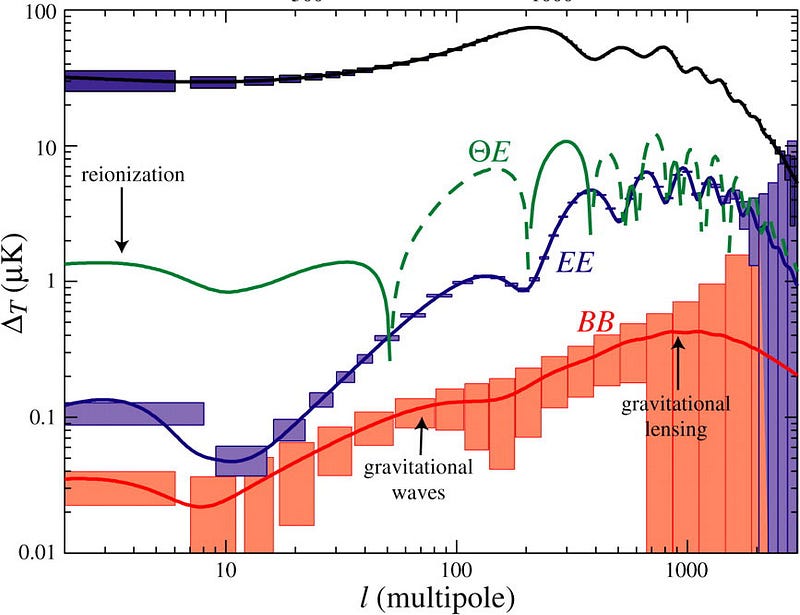
It’s not a “discovery” just yet, but it’s a hint that we might have just stumbled upon something amazing: the first hint of exactly how our Universe was born. If it turns out to be right, it’ll be the discovery of the century! But if it turns out to go away with better data — and it very well may — it doesn’t mean inflation is wrong; it simply means that gravitational waves from inflation are smaller than the most optimistic models predicted.
Whether it pans out to be real or not, we’re about to learn a little bit more about how our entire Universe came to be.
Update: Some of you have weighed in and said the paper reports more than 5σ significance. In particular, they are looking explicitly at this region of angular scales, where they do in fact see a signal at 5.2σ significance.
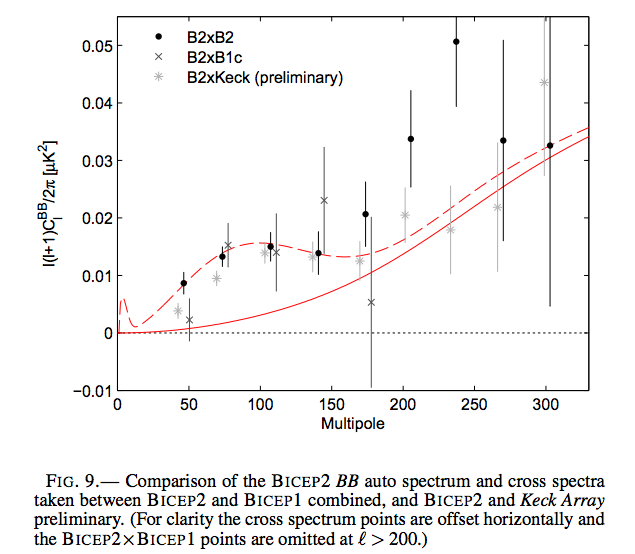
But is lensing potentially responsible? That’s the one component that can only be ruled out — assuming I’m reading the paper correctly — at only 2.7σ.
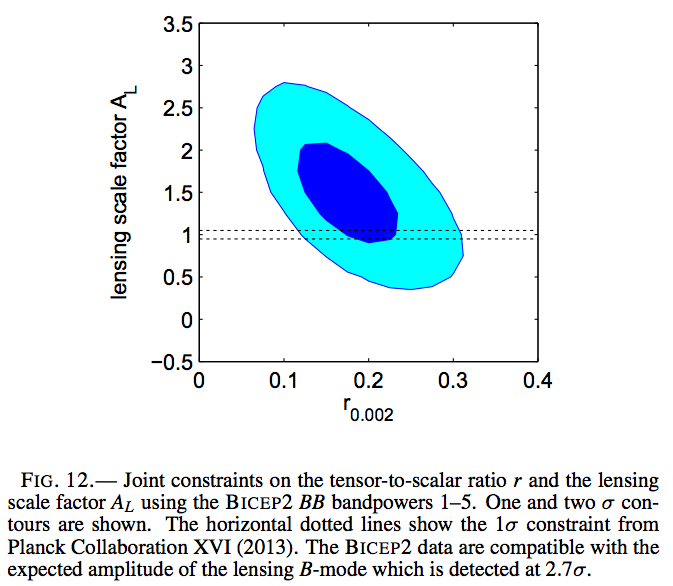
Your result is only as significant as the most likely source-of-uncertainty, and if r could yet be zero, it’s very important to rule that out. The paper may have ruled it out, but it wasn’t clearly presented to me if that’s the case. Still, I’m curious to see how it turns out moving forward! If they can rule out lensing the same way they’ve ruled out synchrotron emissions, the 5σ threshold will have been met, and then we’re talking Nobel Prizes!
For Guth, and for Linde, whose reaction you can see, below:
Have a comment? Weigh in at the Starts With A Bang forum at Scienceblogs!





